
|
Now it is so bright as 11.0 mag (Aug. 9, Juan Jose Gonzalez). It is expected to be bright as 9 mag from 2012 to 2013. In the Northern Hemisphere, it keeps observable in good condition for a long time until 2012 autumn when the comet brightens up to 10 mag. In the Southern Hemisphere, it is hardly observble before the perihelion passage. But it becomes observable in good condition since 2013 after the perihelion passage.
Date(TT) R.A. (2000) Decl. Delta r Elong. m1 Best Time(A, h)
Aug. 11 14 17.58 27 42.4 2.785 2.592 68 10.8 18:51 (153, 22)
Aug. 18 14 23.31 24 40.4 2.790 2.534 65 10.7 18:55 (146, 22)
|

|
It brightened rapidly. Now it is very bright as 10.9 mag (July 30, Katsumi Yoshimoto). It has a large coma. It keeps observable in the morning sky all through this apparition, although it locates somewhat low. It keeps bright at 10-11 mag until mid September.
Date(TT) R.A. (2000) Decl. Delta r Elong. m1 Best Time(A, h)
Aug. 11 5 54.07 23 46.1 1.171 0.933 49 11.0 5:19 (226, 15)
Aug. 18 6 28.45 21 44.5 1.211 0.934 48 10.8 5:12 (230, 14)
|

|
Now it is so bright as 11.3 mag (July 28, Marco Goiato). It is expected to be observable at 11-13 mag for a long time from 2012 summer to 2013 summer. It is not observable until 2013 January in the Northern Hemisphere. In the Southern Hemisphere, it will be extremely low from October to December.
Date(TT) R.A. (2000) Decl. Delta r Elong. m1 Best Time(A, h)
Aug. 11 8 10.64 -71 32.1 2.036 2.238 87 11.5 5:19 (337, 35)
Aug. 18 9 30.66 -71 44.0 2.055 2.209 84 11.5 5:12 (339, 31)
|
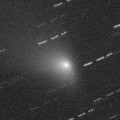
|
It approached to the sun down to 0.12 A.U. on July 14, and brightened up to 7.8 mag (July 22, Juan Jose Gonzalez). Now it is fading in the evening sky. But it is still bright as 10.2 mag (Aug. 9, Juan Jose Gonzalez). It keeps observable while fading rapidly in the evening low sky after this.
Date(TT) R.A. (2000) Decl. Delta r Elong. m1 Best Time(A, h)
Aug. 11 12 55.90 15 38.7 0.969 0.853 50 11.8 18:51 (129, 22)
Aug. 18 13 42.16 8 38.7 1.085 1.003 57 12.9 18:55 (127, 30)
|

|
It kept as bright as 6-7 mag for a long time from 2011 summer to 2012 spring. Now it is not observable. It will appear in the morning sky again at 12.5 mag in October.
Date(TT) R.A. (2000) Decl. Delta r Elong. m1 Best Time(A, h)
Aug. 11 9 38.81 10 53.5 4.302 3.294 5 11.8 18:51 ( 94,-13)
Aug. 18 9 42.88 9 40.6 4.372 3.363 3 11.9 5:12 (268,-15)
|

|
It is expected to be a great comet of -1 mag in 2013 spring. Now it is 11.6 mag (Aug. 8, Marco Goiato). Brightening faster than originally expected. In 2012, it keeps observable until October in the Southern Hemisphere. It will be unobservable in September in the Northern Hemisphere.
Date(TT) R.A. (2000) Decl. Delta r Elong. m1 Best Time(A, h)
Aug. 11 15 1.50 -24 57.6 3.454 3.625 91 12.3 18:51 (119, 72)
Aug. 18 15 0.08 -25 2.5 3.489 3.538 84 12.2 18:55 (107, 66)
|
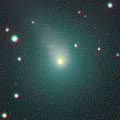
|
It brightened much faster than expected. Now it is so bright as 10.0 mag (Aug. 9, Juan Jose Gonzalez). In the Northern Hemisphere, it keeps observable at 11-13 mag in good condition until early 2013. Although it becomes extremely low in August, it will be getting higher again in the morning sky after September. In the Southern Hemisphere, it is not observable until late 2012.
Date(TT) R.A. (2000) Decl. Delta r Elong. m1 Best Time(A, h)
Aug. 11 9 38.90 50 24.9 2.897 2.151 35 12.8 18:51 (132,-31)
Aug. 18 9 44.63 48 1.1 2.912 2.161 34 12.8 5:12 (231,-33)
|

|
Big asteroid discovered in 1906. It suddenly showed the cometary activity on Dec. 11, 2010, probably due to an impact of a small object. Now it is 11.9 mag (May 29, Marco Goiato). It has already turned to be stellar.
Date(TT) R.A. (2000) Decl. Delta r Elong. m1 Best Time(A, h)
Aug. 11 16 12.01 -27 9.0 1.974 2.473 107 13.4 18:52 (180, 82)
Aug. 18 16 17.48 -27 40.6 2.062 2.478 101 13.6 18:55 (141, 81)
|

|
Now it is bright as 13.1 mag (July 27, Jakub Cerny). It keeps bright as 13-14 mag for a long time after this until 2013. It is not observable in the Northern Hemisphere, but it is observable in good condition in the Southern Hemisphere.
Date(TT) R.A. (2000) Decl. Delta r Elong. m1 Best Time(A, h)
Aug. 11 4 58.90 -53 18.2 5.626 5.695 88 13.7 5:19 (317, 59)
Aug. 18 5 0.30 -53 42.9 5.611 5.710 90 13.7 5:12 (321, 62)
|
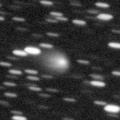
|
Now it is 13.2 mag (July 16, Juan Jose Gonzalez). It keeps bright at 13-14 mag for a long time until 2014. It keeps observable for a long time in the Northern Hemisphere. It is not observable in the Southern Hemisphere.
Date(TT) R.A. (2000) Decl. Delta r Elong. m1 Best Time(A, h)
Aug. 11 22 14.10 57 6.9 5.857 6.227 106 13.8 0:56 (180, -2)
Aug. 18 22 2.42 56 43.6 5.790 6.212 110 13.7 0:17 (180, -2)
|

|
Now it is so bright as 11.5 mag (July 21, Carlos Labordena). It keeps 12-14 mag and observable in good condition until September.
Date(TT) R.A. (2000) Decl. Delta r Elong. m1 Best Time(A, h)
Aug. 11 15 26.70 -12 18.3 5.040 5.207 93 13.9 18:51 (153, 65)
Aug. 18 15 23.33 -12 26.7 5.181 5.216 86 14.0 18:55 (136, 61)
|
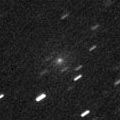
|
Now it is 16.6 mag (July 19, Hidetaka Sato). It was expected to brighten up to 13.5 mag from summer to autumn. But actually, it is much fainter than expected. Sato reported the nuclear magnitude is fainter than 19 mag. Maybe the comet has been disintegrated, and will disappear soon. It keeps observable for a long time until December, but it keeps locating low in the evening after this.
Date(TT) R.A. (2000) Decl. Delta r Elong. m1 Best Time(A, h)
Aug. 11 13 2.94 16 46.5 1.863 1.483 52 14.1 18:51 (131, 22)
Aug. 18 13 21.27 14 3.5 1.834 1.436 51 13.9 18:55 (126, 22)
|

|
First return of a new periodic comet which brightened up to 14 mag in 2005. It was reported so bright visually as 12.8 mag on July 23 (Juan Jose Gonzalez) and 11.6 mag on July 28 (Marco Goiato). It will brighten up to 12-13 mag from summer to autumn, and will be observable in excellent condition.
Date(TT) R.A. (2000) Decl. Delta r Elong. m1 Best Time(A, h)
Aug. 11 1 27.96 5 50.0 0.794 1.538 116 14.1 4:09 (180, 49)
Aug. 18 1 37.71 9 18.1 0.745 1.522 119 13.9 3:51 (180, 46)
|

|
Now it is 13.3 mag (July 11, Jakub Cerny). It still locates high and will be observable until early September in the Southern Hemisphere. It is not observable already in the Northern Hemisphere.
Date(TT) R.A. (2000) Decl. Delta r Elong. m1 Best Time(A, h)
Aug. 11 12 27.15 -11 28.8 6.814 6.251 52 14.1 18:51 (100, 34)
Aug. 18 12 31.17 -11 49.9 6.896 6.251 47 14.2 18:55 ( 96, 29)
|

|
Now it is so bright as 12.3 mag (July 21, Carlos Labordena). Although it was extremely faint as 20.5 mag at the recovery in 2010 autumn, it brightened rapidly. It will keep 12-14 mag and observable in good condition for a long time from 2012 to 2013. But it locates somewhat low in the Northern Hemisphere in 2013.
Date(TT) R.A. (2000) Decl. Delta r Elong. m1 Best Time(A, h)
Aug. 11 13 30.79 0 42.1 3.350 3.020 62 14.4 18:51 (125, 38)
Aug. 18 13 38.24 -0 34.4 3.419 3.010 58 14.4 18:55 (118, 35)
|

|
This comet brightened up to 10 mag in outburst in 1995, however, it became lost after that. The condition of this apparition is bad. It was not observable around the perihelion passage. But it is appearing in the morning sky now.
Date(TT) R.A. (2000) Decl. Delta r Elong. m1 Best Time(A, h)
Aug. 11 6 28.77 13 7.7 2.578 1.954 42 14.5 5:19 (240, 17)
Aug. 18 6 42.70 12 42.3 2.578 2.005 45 14.8 5:12 (239, 19)
|

|
It kept as bright as 11-12 mag for a long time from 2011 autumn to 2012 spring. It is not observable now. But it will appear in the morning sky again at 15 mag in autumn.
Date(TT) R.A. (2000) Decl. Delta r Elong. m1 Best Time(A, h)
Aug. 11 8 16.47 15 4.2 3.554 2.597 16 14.7 5:19 (255, -4)
Aug. 18 8 28.58 14 18.6 3.558 2.628 19 14.8 5:12 (254, -2)
|

|
Looks almost asteroidal. But it has a very faint tail. Bright as 13.9 mag (July 22, Artyom Novichonok). It keeps 14.5-15 mag until mid August. It moves northwards rapidly and keeps observable in excellent condition in the Northern Hemisphere. It locates extremely low in the Southern Hemisphere.
Date(TT) R.A. (2000) Decl. Delta r Elong. m1 Best Time(A, h)
Aug. 11 19 54.79 43 42.1 0.760 1.523 117 14.8 22:29 (180, 11)
Aug. 18 19 10.31 44 6.6 0.881 1.574 112 15.2 21:18 (180, 11)
|

|
Now it is 14.5 mag (July 19, P. C. Sherrod). It is also visible visually at 13.8 mag (July 17, Juan Jose Gonzalez). It keeps observable in good condition at 14-15 mag for a long time until winter. It locates somewhat low in the Southern Hemisphere.
Date(TT) R.A. (2000) Decl. Delta r Elong. m1 Best Time(A, h)
Aug. 11 23 51.47 39 7.2 2.793 3.358 115 15.0 2:33 (180, 16)
Aug. 18 23 51.86 39 33.4 2.710 3.336 120 14.9 2:06 (180, 15)
|

|
Now it is 14.8 mag (July 11, Jakub Cerny). In the Southern Hemisphere, it will be observable at 15-16 mag in good condition for a long time until 2013 summer. It is not observable at all in the Northern Hemisphere.
Date(TT) R.A. (2000) Decl. Delta r Elong. m1 Best Time(A, h)
Aug. 11 17 29.75 -82 12.3 3.438 3.891 109 15.1 20:09 ( 0, 43)
Aug. 18 17 1.73 -82 5.4 3.498 3.891 105 15.1 19:14 ( 0, 43)
|

|
Now it is 14.5 mag (July 17, Yasukazu Ikari). It is also visible visually at 14.2 mag (July 22, Juan Jose Gonzalez). It is expected to approach to the earth and to be observable at 9-10 mag in good condition in winter. The condition is good in the Northern Hemisphere. It locates low in the Southern Hemisphere, and will be unobservable after summer. But it will become observable in good condition after 2013 January.
Date(TT) R.A. (2000) Decl. Delta r Elong. m1 Best Time(A, h)
Aug. 11 15 50.30 47 46.1 1.862 2.010 83 15.4 18:51 (176, 7)
Aug. 18 15 33.80 47 0.6 1.875 1.931 77 15.2 18:55 (168, 7)
|

|
Now it is 14.6 mag (June 30, Jakub Cerny). Jakub Cerny reported the comet brightened in late July. It will be observable in good condition in the Southern Hemisphere while fading gradually after this. It will locate somewhat low in the Northern Hemisphere.
Date(TT) R.A. (2000) Decl. Delta r Elong. m1 Best Time(A, h)
Aug. 11 23 12.30 -24 40.0 2.548 3.481 152 15.7 1:54 (180, 80)
Aug. 18 23 9.14 -25 47.1 2.576 3.533 157 15.8 1:24 (180, 81)
|
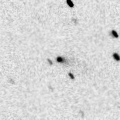
|
Now it is 17.0 mag (July 29, Hidetaka Sato). Brightening rapidly. It will approach to the earth down to 0.4 A.U., and it is expected to be observable in good condition as bright as 15 mag in September and October.
Date(TT) R.A. (2000) Decl. Delta r Elong. m1 Best Time(A, h)
Aug. 11 0 45.07 -16 35.4 0.654 1.529 131 16.4 3:27 (180, 72)
Aug. 18 0 48.13 -13 25.3 0.595 1.502 136 16.1 3:02 (180, 68)
|

|
The condition of this apparition is bad, and it was not observable around the perihelion passage. Now it is 15.7 mag (June 30, Jakub Cerny). It will be fading after this, and will be fainter than 18 mag in late October.
Date(TT) R.A. (2000) Decl. Delta r Elong. m1 Best Time(A, h)
Aug. 11 2 9.17 3 24.1 2.090 2.577 107 16.4 4:51 (180, 52)
Aug. 18 2 10.26 3 20.9 2.042 2.615 113 16.5 4:24 (180, 52)
|
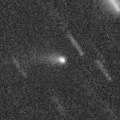
|
Now it is 16.6 mag (July 23, S. Shurpakov). It will brighten up to 15 mag from autum to winter. In the Northern Hemisphere, it keeps observable for a long time until the comet fades out. It is not observable in the Southern Hemisphere, except for 2013 spring, but the comet locates extremely low only.
Date(TT) R.A. (2000) Decl. Delta r Elong. m1 Best Time(A, h)
Aug. 11 14 12.34 74 57.7 2.894 2.732 70 16.7 18:51 (172,-22)
Aug. 18 13 56.43 73 37.6 2.869 2.690 69 16.6 18:55 (168,-22)
|
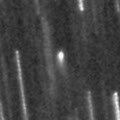
|
It approached to the earth down to 0.17 A.U. in July, and brightened up to 14.5 mag (July 13, Juan Jose Gonzalez). Now it is fading. It has already faded down to 16.0 mag (July 22, Artyom Novichonok). It keeps observable in good condition after this in the Northern Hemisphere. It locates low in the Southern Hemisphere.
Date(TT) R.A. (2000) Decl. Delta r Elong. m1 Best Time(A, h)
Aug. 11 19 30.98 34 22.7 0.301 1.206 123 16.7 22:10 (180, 20)
Aug. 18 19 41.45 36 56.1 0.344 1.228 121 17.1 21:53 (180, 18)
|
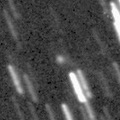
|
Now it is 16.5 mag (July 23, A. Diepvens). It is expected to brighten up to 10 mag from winter to spring in 2013. In the Northern Hemisphere, it keeps observable in good condition until 2013 April. It is not observable now in the Southern Hemisphere. It will become observable after 2013 April, but it keeps locating low.
Date(TT) R.A. (2000) Decl. Delta r Elong. m1 Best Time(A, h)
Aug. 11 1 35.48 83 26.0 3.763 3.684 77 17.0 4:18 (180,-28)
Aug. 18 1 48.93 84 48.4 3.660 3.616 79 16.9 4:04 (180,-30)
|
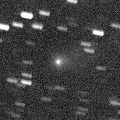
|
Now it is 16.8 mag (July 25, K. Hills). It tends to brighten after the perihelion passage. It keeps observable at 16-17 mag from 2012 to 2013. It locates somewhat low in the Northern Hemisphere.
Date(TT) R.A. (2000) Decl. Delta r Elong. m1 Best Time(A, h)
Aug. 11 16 10.90 -19 9.7 2.690 3.121 105 17.0 18:51 (179, 74)
Aug. 18 16 14.86 -19 40.3 2.784 3.124 100 17.0 18:55 (156, 73)
|
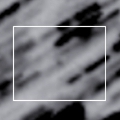
|
First return of a new periodic comet discovered in 1994. Now it is 18.9 mag (July 24, V. Gerke, S. Plaksa, A. Novichonok). It will brighten up to 13.5 mag and will be observable in good condition from autumn to winter.
Date(TT) R.A. (2000) Decl. Delta r Elong. m1 Best Time(A, h)
Aug. 11 19 33.98 32 11.0 1.198 1.970 125 17.3 22:12 (180, 23)
Aug. 18 19 27.27 31 57.5 1.152 1.907 123 17.0 21:38 (180, 23)
|

|
It brightened up to 10 mag from autumn to winter in 2011. Now it is appearing in the morning sky again in the Southern Hemisphere. It has already faded down to 16.6 mag (June 30, Jakub Cerny). It keeps observable in good condition while fading graudlaly after this. It will be hardly observable in the Northern Hemisphere.
Date(TT) R.A. (2000) Decl. Delta r Elong. m1 Best Time(A, h)
Aug. 11 5 1.21 -25 30.8 4.388 4.255 75 17.1 5:19 (263, 58)
Aug. 18 5 3.48 -27 20.4 4.367 4.314 80 17.2 5:12 (263, 62)
|
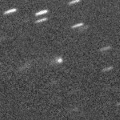
|
Now it is 17.4 mag (July 24, A. Diepvens). It keeps 17 mag for a long time from 2009 to 2013.
Date(TT) R.A. (2000) Decl. Delta r Elong. m1 Best Time(A, h)
Aug. 11 23 12.29 13 50.1 7.624 8.431 140 17.2 1:54 (180, 41)
Aug. 18 23 7.46 13 31.9 7.575 8.444 147 17.2 1:22 (180, 41)
|
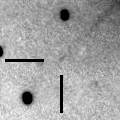
|
It was observed at 17 mag in 2011 autumn. It will be observable at 17 mag in good condition again from autumn to winter in 2012. It locates low in the Southern Hemisphere.
Date(TT) R.A. (2000) Decl. Delta r Elong. m1 Best Time(A, h)
Aug. 11 5 39.50 17 53.9 3.392 2.908 53 17.3 5:19 (227, 22)
Aug. 18 5 48.72 18 41.6 3.324 2.919 58 17.3 5:12 (224, 23)
|

|
Now it is 17.4 mag (July 24, Siding Spring Survey). It keeps 17.5 mag until September. It is observable in excellent condition in the Southern Hemisphere. But it locates somewhat low in the Northern Hemisphere.
Date(TT) R.A. (2000) Decl. Delta r Elong. m1 Best Time(A, h)
Aug. 11 21 40.64 -29 27.8 0.601 1.602 165 17.4 0:23 (180, 85)
Aug. 18 21 35.42 -26 25.9 0.599 1.601 166 17.4 23:46 (180, 81)
|
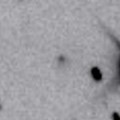
|
First return of a new periodic comet discovered in 2005. Now it is 18.3 mag (July 23, V. Gerke, S. Plaksa, A. Novichonok). It will be observable in excellent condition at 17-18 mag until November.
Date(TT) R.A. (2000) Decl. Delta r Elong. m1 Best Time(A, h)
Aug. 11 23 33.14 4 42.2 1.325 2.216 142 17.7 2:15 (180, 50)
Aug. 18 23 31.22 5 7.9 1.278 2.208 149 17.5 1:46 (180, 50)
|

|
It was observed at 12.5 mag on Apr. 1, as bright as expected (Michael Jager). However, it has faded very rapidly. Hidetaka Sato reported that it has been already too faint to catch, fainter than 19.0 mag on June 25. In the Northern Hemisphere, it will be high after this. In the Southern Hemisphere, it will never be observable again.
Date(TT) R.A. (2000) Decl. Delta r Elong. m1 Best Time(A, h)
Aug. 11 5 21.31 46 48.4 3.433 3.037 58 19.7 5:19 (207, 0)
Aug. 18 5 30.20 47 4.7 3.426 3.110 63 19.9 5:12 (205, 1)
|
|
![]()
 78P/Gehrels 2
78P/Gehrels 2 P/2012 NJ ( La Sagra )
P/2012 NJ ( La Sagra ) C/2012 J1 ( Catalina )
C/2012 J1 ( Catalina ) C/2011 O1 ( LINEAR )
C/2011 O1 ( LINEAR ) C/2012 K5 ( LINEAR )
C/2012 K5 ( LINEAR ) C/2011 A3 ( Gibbs )
C/2011 A3 ( Gibbs ) 168P/Hergenrother
168P/Hergenrother 71P/Clark
71P/Clark C/2012 L1 ( LINEAR )
C/2012 L1 ( LINEAR ) 189P/NEAT
189P/NEAT C/2012 L2 ( LINEAR )
C/2012 L2 ( LINEAR ) 152P/Helin-Lawrence
152P/Helin-Lawrence 262P/2012 K7 ( McNaught-Russell )
262P/2012 K7 ( McNaught-Russell ) C/2010 G2 ( Hill )
C/2010 G2 ( Hill ) C/2008 S3 ( Boattini )
C/2008 S3 ( Boattini ) P/2011 N1 ( ASH )
P/2011 N1 ( ASH ) P/2012 O3 ( McNaught )
P/2012 O3 ( McNaught ) 261P/2012 K4 ( Larson )
261P/2012 K4 ( Larson ) C/2011 Q2 ( McNaught )
C/2011 Q2 ( McNaught )![]()

































